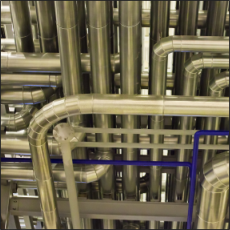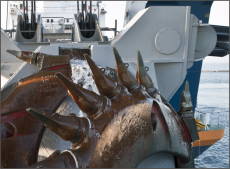Phillips and Jordan Leverage Multiple Expertise
by Mark Scheer
If our articles were roads, this feature would be the winding stretch in those advertisements where they test drive cars with the disclaimer ‘professional driver on closed course’-it is filled with sweeping curves and hairpin turns. But properly introducing Phillips and Jordan Inc. requires such an effort; you just can not tell a story that starts with a guy and a chainsaw and ends up at the World Trade Center forensic recovery effort and ultimately to a dredge automation project any other way.
Based in Knoxville, TN, Phillips and Jordan is well-represented throughout the country. To help us unfold this interesting evolution, we spoke with Chris Branas, technical manager at their Zephyrhills, FL office.
As with the growth of many large, successful companies, Phillips and Jordan started modestly, and mostly stayed that way for the first several decades of its existence. “Ted Phillips started in business back in 1949 when he partnered with his cousin to do a $495 TVA timber cutting project in Mississippi,” Branas explained.
Phillips continued to pursue more land-clearing opportunities back in his native North Carolina and after graduating from high school, teamed up with Ted Jordan, a high-school friend, and founded Phillips and Jordan in 1952. Over the next several years, the two men invested in more powerful chain saws, and acquired the company’s first bulldozers.
As the company secured larger opportunities, such as clearing for the West Virginia Turnpike, and the Flaming Gorge reservoir in Utah, Phillips and Jordan was earning a reputation for performing high-quality, dependable work while generating a decent and fair profit in the process. They continued to grow their land-clearing business until 1970, when they chose to separate their interests, selling the business to publicly traded Kaneb Corporation. Phillips continued to manage the company for the next 15 years, until he reacquired the company in 1985.
Today, Phillips and Jordan is a heavy civil construction and site development company, concentrating their expertise on very large residential development and industrial sites. “We mostly do the land clearing, earth moving and utility work-putting in the storm, sewer and sanitary systems,” continued Branas. “When Ted Phillips bought back the company in the mid-1980s, the real evolution of Phillips and Jordan began. Our president, Ben Turner, has been instrumental in leading the transformation of P&J into the modern construction company that we are today.”
Heavy civil construction is not the only expertise at Phillips and Jordan. “We are also one of the leading disaster recovery contractors in the United States,” Branas added. “We have pre-positioned contracts for the Army Corps of Engineers in about half the states.”
When Hurricane Andrew struck south Florida in 1992, there was no system for pre-placing disaster response contractors. Phillips and Jordan was selected as one of the five contractors to clean-up after Andrew, and ultimately ended up clearing and processing almost 70 percent of the debris generated by that storm.
Phillips and Jordan has responded to numerous disasters, handling the responsibility of clearing the streets of debris to allow emergency vehicles access to an area, processing the debris, and performing other clean up services. Their capabilities continued to evolve, as they now offer logistics and advising services as well. That knowledge was well-demonstrated when they were tapped to oversee the World Trade Center recovery effort in 2001. “We didn’t do the actual demo loading on site, but once the material was put on the trucks and hauled away, we took over,” explained Branas.
“We took the material from the trucks and loaded them on a barge to bring down-river to the landfill site, where we unloaded it and managed the whole forensic recovery effort.” Branas emphasized that the WTC debris clean-up was obviously not a typical clear and dump project. “The FBI was involved, and it was obviously a very sensitive effort. But before we got involved, it was not being handled very efficiently,” he continued. “They were initially processing about 4000 tons per day, but in just seven days we established our systems and brought in more appropriate equipment and were doing 18,000 tons [per day] and recovering more articles and evidence per cubic yard of debris processed.”
Not surprisingly, Phillips and Jordan was called on following the devastation that Hurricane Katrina brought in 2005. “We received some enormous contracts as a result of Katrina,” said Branas. “That storm brought destruction on a scale not really ever seen before in the United States, and responding to that effort has been challenging for everyone involved.”
“Our civil construction division accounts for the larger portion of our business overall, but depending on current demands, disaster recovery can represent almost half our revenue, especially if you looked at a snapshot that included the Katrina era,” Branas detailed. “Our capabilities are a direct function of having such a diverse and talented team of managers and planners that can leverage their knowledge and experience in whatever application they are called on to perform.”
Branas’ path into Phillips and Jordan echoed that sentiment. “I was working in IT when I came here,” he explained. “They sent me to Texas to work on a geophysical line clearance project for an oil and gas company that required the implementation of a GPS guidance system. They figured since I was the IT guy, I had to make it work!” Needless to say, Branas was successful, and was quickly handed more equivalent responsibilities on other projects. The ability to identify talent and value among their team is one of the greatest strengths of Phillips and Jordan.
Ted Phillips, who still serves as the company’s chairman and chief executive officer, is also one of the primary owners of a Florida aggregate company. And although they are separately owned companies, Phillips was able to leverage the expertise of Phillips and Jordan to assist Palm Beach Aggregates in a dredging automation project in 2005. “They will request our assistance on projects that may be outside of their own employees’ expertise,” said Branas. “They understand mining and aggregate production; but we have some very talented managers and skilled technicians. So when the potential of implementing a dredge automation system arose, it was obvious for us to work together.”
Palm Beach Aggregates began their dredging operation when their permitted site had been conventionally mined down to the water table. When the Southwest Water Management District approached them with an opportunity to dredge the site to create a water storage solution, Palm Beach Aggregates needed to transform their operation to dredging.
“Ben [Turner] played an instrumental role in developing a solution by bringing dredge consultants from Louisiana in to help us get the proper system; I got initially involved to help outfit a GPS navigation system to feed the software on the dredge,” Branas continued. “It was not so much an automation solution at that point, but more of a well-informed display system to enable better manual control.”
The solution worked for about two years, but Palm Beach Aggregates knew they could further improve their production levels with better dredge control. The resources at Phillips and Jordan were again tapped, and Turner approached Branas for his expertise a second time. “Ben came to me in the summer of 2005 and asked me if I thought we could automate the dredge now. At that point, I was much more familiar with the whole operation, and knew we could get it done.”
The initial goal was to find an automation partner to work with in development of the necessary software and systems on the dredge. “We interviewed several contractors. Basically, you get two kinds of people in the technical world-those who try to make you feel like you don’t know what you’re talking about, who are reluctant to share any information with you at all, and people who are willing to try and work together to solve the problem. Unfortunately, the latter of the two does not always have the experience necessary regardless of their willingness to complete the task. But when we talked with Jay Wise at Kruse Controls, it was the total opposite experience. He was quite willing to share any information and explain his thinking at as deep a technical level as you were willing to engage, and it was obvious that Kruse Controls possessed the technical know-how to get the job done.” Such openness and knowledge was appealing to Branas and the teams from Phillips and Jordan and Palm Beach Aggregates, and the decision to work with Kruse Controls was easily made.
“He first came to our site to review the operation, discover what we needed and share some dredge automation projects he had done previously,” Branas added. “But nothing was really quite like ours. This was the biggest dredge he had ever worked on.” The Palm Beach Aggregates dredge, nicknamed the Sam Houston, is a 30” cutter suction dredge designed with a 10-foot cutter head capable of cutting into hard rock. Because of that ability, the Sam Houston dredge frequently encounters both hard rock and softer sand material during its operation. Accommodating that variability of material was one of the greatest challenges on this automation effort.
“Jay is just so good at what he does,”praised Branas. “He had to come up with some PLC algorithms that were able to properly address the constantly changing material conditions. That’s pretty tough because it is much more intense to make decisions quickly when the material is changing all the time. You have to adjust so many variables…keep the suction pressure right for example, to ensure that you don’t get 18,000 feet of 30” pipe clogged with sand.” The stakes on such a project were quite high, and Branas understood the consequences. “This [dredge] is basically a floating industrial plant, downtime is not an option. Obviously there are times when wear parts need to be replaced or you shut down for maintenance, but computer and software errors are absolutely not acceptable.
While Wise served as the hard code programmer, Branas assisted in the conceptual process. “I certainly understand code to some level, so I served as more of a visionary. Jay and I would brainstorm the solution ideas, and he would implement the code.” And as any programming project unfolds, the capabilities continued to expand. “Feature creep definitely set in; the more you get done, the more ideas come up.” But in the end, the final product was far more than most anyone could have expected. “We did this all in six months,” Branas continued. “We automated the dredge control, created charting and reporting capabilities in real time, and even created a VPN remote access port for Jay to sign in to the dredge in real timeto make and revisions or adjustments that we may need. He has always gone above and beyond what is expected.” Upon completion, dredge production increased almost 100%, growing from 600-700 thousand yards per month, to over 1.3 million. Jay has since been retained for involvement on two other Palm Beach Aggregate projects, both involving conveyor automation.
Any story about a man and a chainsaw that concludes with a million-plus yard-per-month dredging automation project is going to be extraordinary. As an engineer or project manager for Phillips and Jordan, you have to come to expect the unexpected. People are not called upon to fill a tightly scripted role. Rather, they are counted on to leverage their talents and experience in an effort to broaden their own capabilities, and expand the capabilities of the company. Chris Branas is just one on a team that can be as large as 1500 people, and his talents have been called upon for applications as varied as oil and gas exploration to dredge automation. Phillips and Jordan may identify themselves as a heavy civil construction and disaster recovery company, but they clearly understand how to most effectively leverage their assets-both human and mechanical, to solve problems and create opportunities wherever they may exist. Working in such an environment will never become routine.












